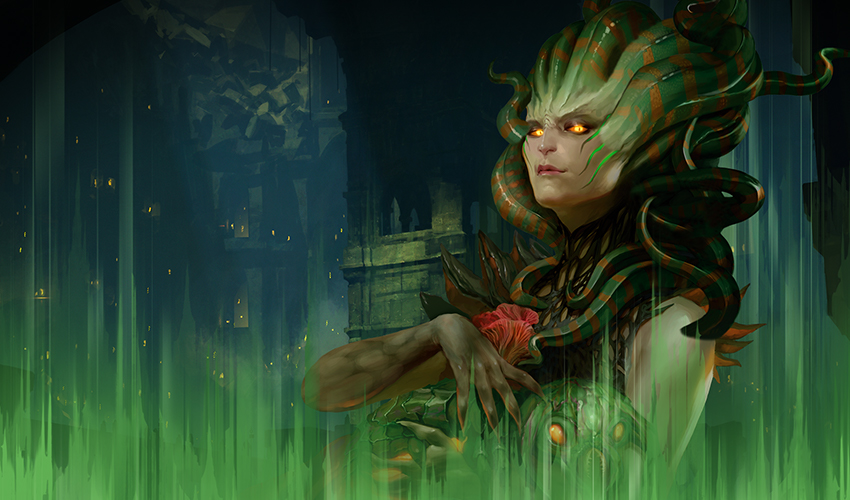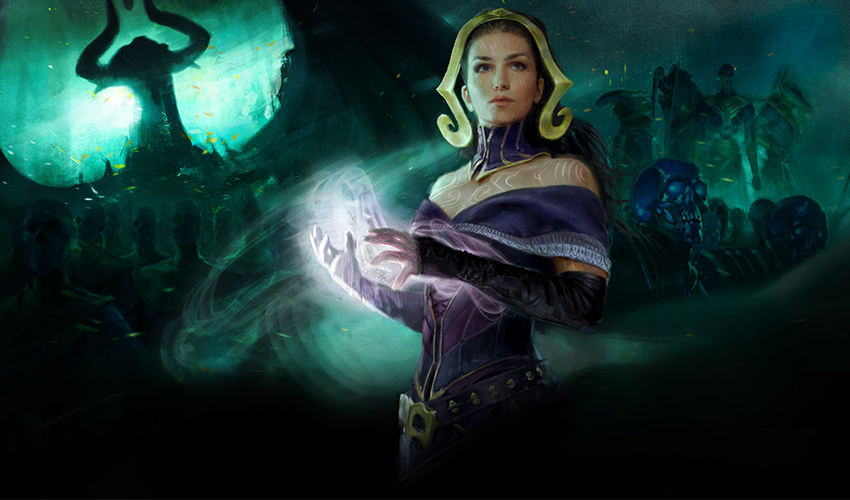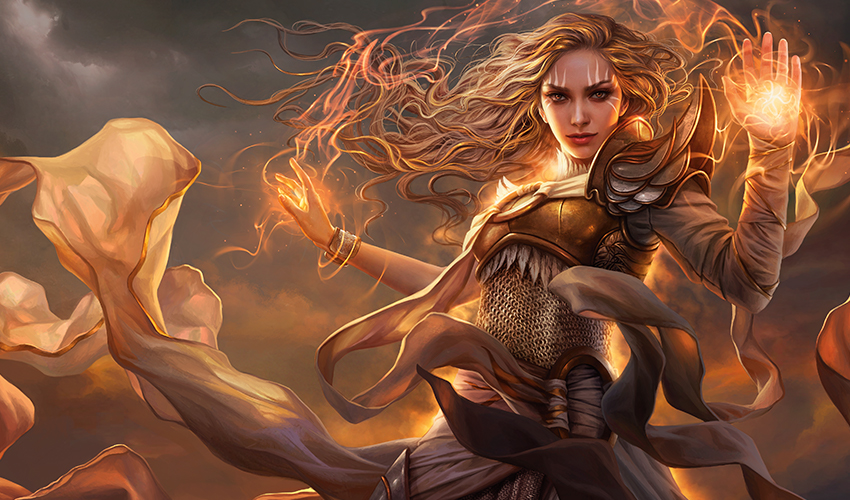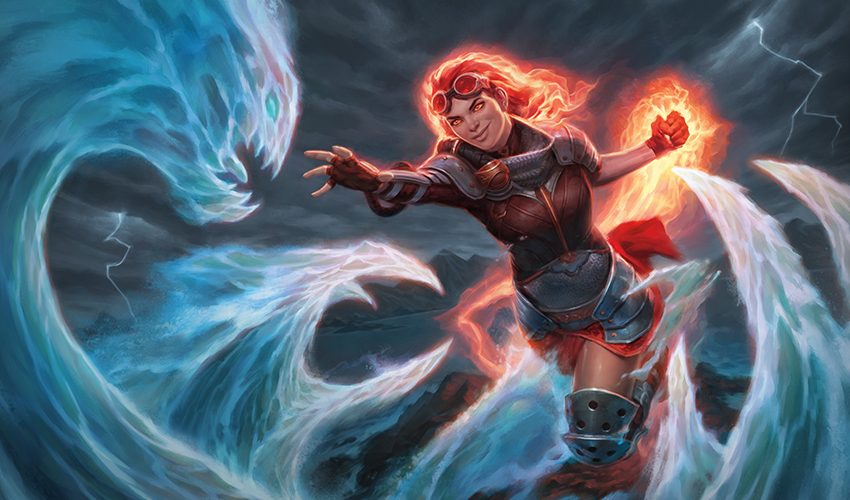State of Design 2019
When I became head designer back in 2003, I decided I wanted to write a yearly article based on the US president's State of the Union speech where I look back at the last year of Magic and analyze how I felt the design went. This is my fifteenth "State of Design" column. (I started writing the articles in 2005, as it was the first year that the work I oversaw as head designer came out.) Here are the links to my last fourteen columns:
Here's how this article is structured. I'll start talking about the last year's Magic design as a whole, detailing both highlights and lessons of the year. I'll then talk about each booster release, also giving highlights and lessons. But before I get to that, I always start with the same question:
How was the last year of Magic design?
I would say very good. I feel like Dominaria was a big turning point for R&D for numerous reasons. One, we changed over from the design/development process to the vision design/set design/play design model, and I feel it's just a better way to make Magic sets. Less work is wasted, and we're ending up with more polished, better designed (and thus more fun) sets.
Two, the creation of the Play Design team has helped us make better overall play environments. Not only has the banning of cards gone way down, but we've been able to make sets where the power in the cards greatly overlaps with what's fun about the sets.
Three, we've had some shifts in philosophy that have led to better Magic gameplay, things like creating more answers to threats and putting many of those answers at lower rarities to help in Limited.
Four, we've been more willing to push boundaries in our designs. That's led to things like War of the Spark and Modern Horizons, probably our two biggest successes of the last year (more on those sets below).
That said, let's take a look at the last year of Magic design.
Overall Magic Design
Highlights
- R&D is starting to hit the right level of complexity.
Two years ago in my "State of Design" articles, I said we'd let complexity get a little too high. Last year, I said we overcompensated and ended up with complexity a little too low. I'm happy to say that we've found the middle ground and have been producing sets that seem to be hitting the sweet spot.
The key to this success seems to be us towing the line of complexity at common, but upping the amount of complexity we allow at uncommon. This allows us to take in-theme things for the set that would normally be rare and pull them down to uncommon to allow us to raise the as-fan of the theme. A good example of this would be the planeswalkers in War of the Spark. The uncommon planeswalkers, in a vacuum, would probably be rares in a normal set, but by allowing ourselves to lower their rarity, we were able to infuse War of the Spark (especially Limited) with the planeswalker theme.
Another component that allowed us to pull this off is a willingness to be more aggressive with the power level of commons, especially answers, to help make them more relevant without having to up their complexity.
- We're getting better at hitting player desires.
A big part of Magic design is making the cards that players want to have. Accomplishing this is a multi-level process. First, you have to have a system that allows for communication with the public so that you understand what it is they want. Second, you have to craft sets that organically allow you to hit many of those themes. Third, you need the follow through on the design so that you're making cards that actually meet the player demands. This is a very complex sequence, but I believe it's one we're getting very good at.
My example here would be Modern Horizons. We spent a lot of time making sure we understood what themes we could use that would best hit player demands and managed to put a lot of things in the set, such as changeling, Slivers, Ninjas, and snow, that met long-time player desires.
- We're embracing new tools to help us make better designs.
This is one of those things that's a little more behind the scenes but a crucial part of how we're making better sets. Basically, it's an attitude to think of all the different components of making a set as tools that design can use. This is really a trend that's been going on for years, but I feel the last year has us fully embracing the philosophy.
For example, collation is the tool we use to ensure a balanced, yet random, mix of cards in boosters. Part of the success of the planeswalker theme in War of the Spark was us using a complex collation scheme to ensure that every booster pack had a planeswalker that appeared in the rarity slot of that planeswalker (meaning planeswalkers didn't need their own dedicated all-planeswalker slot in boosters).
Another example is our willingness to make use of frames as a component to enhance new design space. Most of the uses over the last year were subtle, but you'll see in the coming years that we're ramping up this tool.
Lessons
- We could use more synergy between the sets.
One of the big shifts over the last few years has been the move away from the traditional block structure. A major side effect of this move has been a larger number of mechanical themes in Standard as each set tends to have its own toolbox of stuff. The downside of this shift is that it's harder to play various sets with one another as each is pushing in a different direction. The solution to this problem is for design to find more mechanical synergies between sets such that the mechanics work together rather than fight with one another.
- We need to spend more time on pacing.
One of the common complaints I got last fall was about the gap between Guilds of Ravnica and Ravnica Allegiance. One of the common complaints I got this spring/summer was about the cramped timeframe between War of the Spark and Core Set 2020 releasing (with Modern Horizons in the middle). We need to get better at letting sets have room to breathe while also making sure players never have to go too long without a new Draft environment. Part of this is about balancing set releases in general, and part of it is about being better at moving between products aimed at different audiences.
Guilds of Ravnica and Ravnica Allegiance

I'm going to be talking about these two sets together as they were designed together and really hold together as a larger unit.
Highlights
- We executed well on the guilds.
The number one job of a Ravnica set is to deliver on the ten guilds. It's what makes Ravnica Ravnica, and you can tell a lot of time was spent on this goal. Each of the guilds had a clear mechanical identity and a keyword mechanic that played into it. A lot of the compliments I received on these two sets were from people telling me they were happy with how their favorite guild played and worked in the kinds of decks they wanted to build.
- All the mechanics played well.
Another frequent compliment I got was how the guild mechanics played well. They mostly weren't splashy (I'll get to this in a minute), but they were functional and useful. They worked well interacting with the guilds overlapping with them and they allowed players to build guild decks.
- Players liked the overall tone of the sets.
One of the complaints of previous Ravnica sets was that there's never been much of a story. Yes, you got to see all the guilds in action, but you never got a sense of a larger issue happening in the world. Guilds of Ravnica and Ravnica Allegiance were different in this regard. The set had a clear mood with its "cold war" feel, and it was obvious that something dark and sinister was happening to the Plane. Even if you didn't know exactly what Nicol Bolas was up to, you got a sense it wasn't something good and that the whole Plane was in jeopardy.
Lessons
- There wasn't enough innovation.
My biggest issue with Guilds of Ravnica and Ravnica Allegiance was the same issue I had with Return to Ravnica block—they recreate the feel of Ravnica established by the original Ravnica block, but never innovate on it. Both revisits have been a return to how design was done when we originally made Ravnica fourteen years ago. Yeah, we've made small additions (like the half-gold/half-hybrid split cards), but we've never really re-envisioned the world through a modern design eye. This was done consciously this time because we knew War of the Spark was really going to push the boundaries, but I hope when we come back to Ravnica many years from now that we can reinvent it mechanically in some way.
- The mechanics lack oomph.
All the keyword mechanics played well, but none of them really made anyone sit up and pay attention. Nothing had an aura of "this is different" or "this is quirky, but very flavorful." Part of this is due to the nature of guild sets. Having five mechanics forces you to keep complexity down, and the needs for Draft push you to mechanically overlap certain guilds, limiting your options. All that said, I wish at least a few of the guild mechanics had a little more pizazz. (And one of these days, I'd love an Izzet mechanic that plays into the creativity of the guild.)
- Ravnica Allegiance Limited play didn't have the depth of Guilds of Ravnica.
This was another common complaint I got from drafters. Guilds of Ravnica was structured to have a little more replay in a draft, and a lot of players wished that Ravnica Allegiance had followed suit.
War of the Spark

Highlights
- Players loved the planeswalker theme.
There was a lot for players to like in War of the Spark, but the number one thing was crystal clear: players enjoyed getting a planeswalker in every pack. They enjoyed uncommon and rare planeswalkers. They enjoyed hybrid planeswalkers. They enjoyed planeswalkers having static abilities (although, there was one aspect of it they didn't like that I'll get to below). They enjoyed the planeswalkers each having a signature spell (or two). They enjoyed the Japanese promotion with alternate-art planeswalkers. They enjoyed the fact that Limited games just involved a lot of planeswalkers in the gameplay. They pretty much liked everything about the theme.
- The fact that it was an event set came through loud and clear.
When I first talked about War of the Spark being an "event set," a lot of players didn't quite understand what that meant. But once the set came out and players could see the story spelled out over all the cards, the response was very positive. I had a number of players tell me that it was the first set where they really got a strong sense from the set that there was a story going on behind the cards you were playing. They also enjoyed that the set had a strong sense of the characters of the story, both in the planeswalkers and in the many legendary creatures in the set (some of which they'd been asking to see for years).
- Proliferate and amass
The two named mechanics of the set also performed very well. We knew players enjoyed proliferate, and it was great to finally find a way to bring it back. A lot of players commented how they enjoyed that this time around, proliferate was more about building up than tearing down (as it had been in Scars of Mirrodin block). I was also very happy to see amass get the positive reaction that it did. It was designed to fulfill a story need (representing Bolas's undead army) which meant that it ended up feeling very unique and unlike things we've done before.
Lessons
- There were too many rare/mythic rare bombs.
This is the most common complaint I got about the set. Players, in general, loved the Limited gameplay, but they disliked how many rare and mythic rare cards there were that were next to impossible to answer with common and uncommon cards, with the God-Eternals being the biggest culprits of this issue. It's possible that this problem could be solved with more low-rarity answers rather than fewer rares and mythic rares that are powerful in Limited.
- The static ability of some planeswalkers was hard to remember.
In general, the planeswalkers were beloved, but they did create one common complaint. Because every planeswalker had a static ability and we had so many planeswalkers, a number of the static abilities were things that just didn't come up often, making them very hard to track. The planeswalker that got cited most for this problem was Narset, Parter of Veils.
She's an uncommon planeswalker with an ability that doesn't come up a lot but is very devastating when it does. In retrospect, I think we needed to be a bit more careful with the uncommon static abilities.
- [CENSORED] didn't have a card.
WARNING: This section contains story spoilers
Another major complaint I got was that Dack Fayden didn't get a card in the set. He dies in the book, but due to the timing of the novel being written, we didn't know early enough to get his death, or even his card, into the set. Having major disconnects between a big story point and the set is frustrating, and we're trying to figure out behind the scenes if there is anything we can change about the process to avoid things like this happening.
Modern Horizons

Highlights
- Players enjoyed the Time Spiral–like goodness of the set.
When Ethan Fleischer and I pitched Modern Horizons, we claimed there was an audience for a high-complexity, nostalgia-rich set. Yes, Time Spiral block was a bit much as a Standard-legal set, but we believed it could thrive as a supplemental set. Well, we were correct. Modern Horizons was a huge success. Fans of the set loved that it had 40-plus non-evergreen mechanics all comingling together. The key was recognizing that while it wasn't for everyone, it did have an audience, and that audience adored it.
- The set's flavor really resonated.
Just as the mechanics of the set went deep with the nostalgia, so too did the flavor. The set was crammed full of nods to the characters, places and events of Magic's past. Urza finally appeared on a black-border card, as did Yawgmoth, Serra, and Pashalik Mons. It was also full of Easter eggs, allowing players to geek out at almost every art and name and flavor text. All in all, the Vorthoses of the world were quite happy with Modern Horizons.
- The set delivered on a lot of long-desired themes.
One of the things I do is track all the many requests I get from players. Often, it's hard to get too many demands in any one set due to the restrictive nature of building a unique world, but Modern Horizons had none of those issues, so we got to do Slivers and Ninjas and changeling and snow. We got to revisit mechanics players thought they'd never see again. We also got to make a bunch of individual cards players have been asking for. I have a long checklist, and we got to check a lot of things off.
Lessons
- The name misled people.
This is by far and away the biggest complaint I got about the set. We'd designed a Time Spiral 2–ish, high-complexity, nostalgia-rich set, and the name (and how we initially talked about it) created an expectation that it was more about a set maximizing Modern. Yes, it was the first ever straight-to-Modern set (which is why Modern was in the name) and we spent a lot of time making sure the set added cards to Modern, but there was much more to the set than that, and we could have done a better job setting those expectations.
- It was too easy to get into traps drafting the set.
There was a lot going on in the set due to its complex nature. This led to a frequent issue in Draft where someone took a card early and assumed that implied a theme that wasn't supported at the volume it would need to be drafted. This isn't an easy problem to solve as the quirky, one-off nature of the set is a feature most of the time. My best guess is we could have spent a little more time educating the drafters about what was and wasn't viable to draft.
- Players didn't get enough chance to draft the set.
With the tight time window between this set and Core Set 2020, and the higher price point of the boosters, I got a lot of feedback from players saying that they wanted to draft this set more but were unable to get a group of eight players to draft it. I'm hoping with time that this might be the kind of Draft environment players turn to when there's a lull between Magic sets.
Core Set 2020

Highlights
- The set drafted very well.
The biggest compliment I've received about Core Set 2020 is that it's a really fun set to draft. Yoni Skolnik and his design team spent a lot of time trying to build a core set that allowed interesting drafting options while still functioning as a basic core set. It seems they succeeded.
- The set provided cards for a lot of different formats.
Because the core set is positioned as the eighth set in Standard, it has a lot of competition for playable cards. To help offset this, the set included a bunch of cards designed for formats other than Standard. This was noticed and appreciated by the audience. This was a source of a lot of positive feedback, especially the cycle of wedge legendary creatures.
- The set had a lot of cards aimed at lower-tier Standard decks.
One of the other things that core sets are well placed to do is help pump up decks that haven't managed to be competitive, especially with themes of the year about to rotate out (we can be much more aggressive with those themes, as any mistake would rotate out in three months). This was noticed and appreciated by the players.
Lessons
- The set didn't have a particularly strong theme.
In the past, the core sets have never had a particularly strong theme (well, other than Magic Origins), but Core Set 2019 played into a Nicol Bolas theme—one that ended up filling more space than this year's Chandra theme. As a result, a lot of players felt as if Core Set 2020 was a bit light in theme. This leads to an interesting question about how strong of a theme a core set is supposed to have, with next to none at one end and Magic Origins (or maybe even further) at the other. Listening to player feedback, it seems most of you would rather more theme than less.
- Some players are starting to feel planeswalker fatigue.
As I stated with War of the Spark, the planeswalker theme was popular, but not with everyone. Chandra's three-planeswalker gimmick hit a sour note for those players who have had their fill of planeswalkers (although, was much beloved by planeswalker and, particularly, Chandra fans).
Looking Back
In general, I believe this last year was a good one for Magic design, but I leave with the takeaway that players seem more enamored when we're willing to push boundaries and try new things than when we just stick with the status quo. War of the Spark and Modern Horizons seem to be the breakaway sets of this year and both took pretty big risks, design-wise. Luckily, looking forward, we're definitely not resting on our laurels and will be trying some new things. I'm interested to write this a year from now and see how much of it went.
I'm always eager for feedback, but especially with my "State of Design" articles. I told you what I thought of the last year. I'm eager to hear what you thought (both of this last year of design and my take on it). You can email me or contact me through any of my social media accounts (Twitter, Tumblr, and Instagram).
Join me next week when I . . . well, you'll just have to be patient.
Until then, may you enjoy looking back at the last year of whatever you've been up to.
#665: Lessons Learned – Unstable
#665: Lessons Learned – Unstable
37:28
This is another in my series "Lessons Learned" where I examine the lessons I've learned from sets I led or co-led. Today, I talk about the third Un- set, Unstable.
#666: Demons
#666: Demons
29:46
This podcast is about the history of the Demon creature type.
- Episode 664 Milling
- Episode 663 Modern Horizons Cards, Part 4
- Episode 662 Modern Horizons Cards, Part 3

